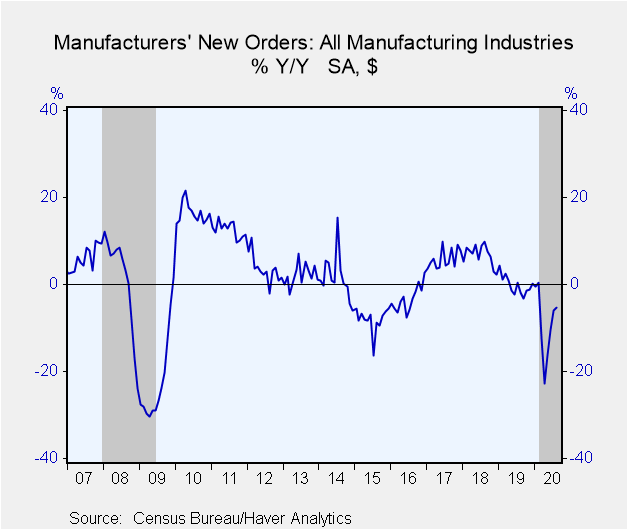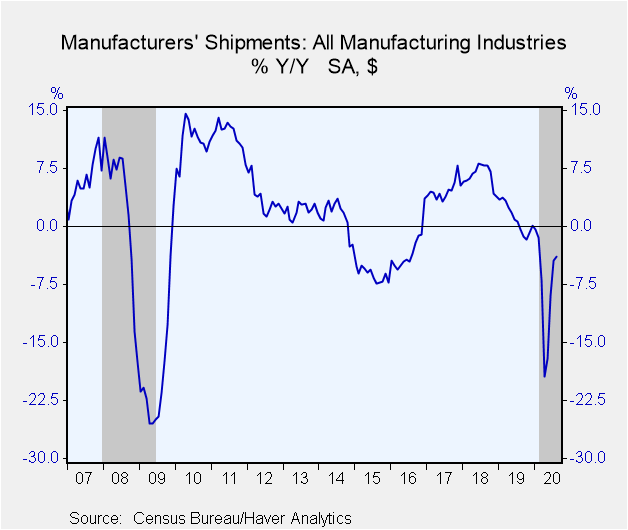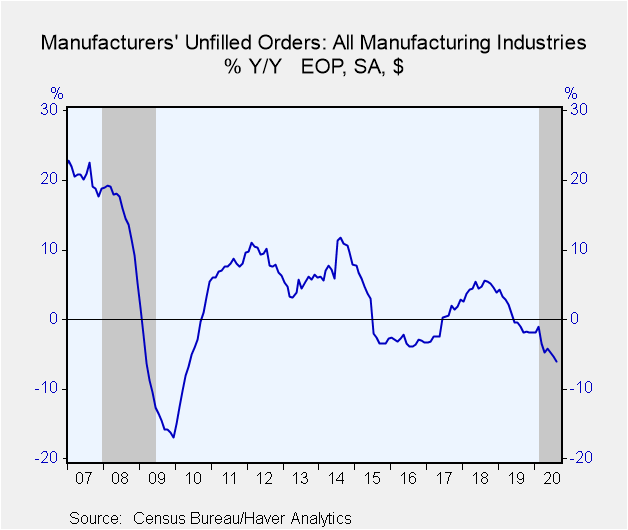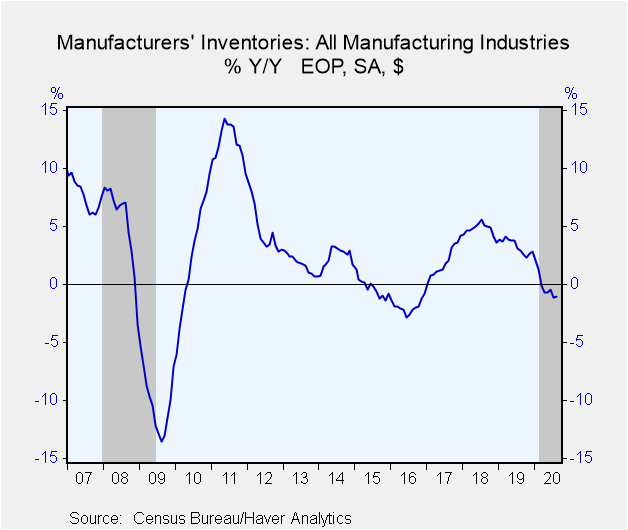 Global| Oct 02 2020
Global| Oct 02 2020Factory Orders and Shipments Slow in August After Three Strong Months
Summary
• Factory orders growth decelerated to 0.7% in August. • Shipments down to 0.3%. • Order backlogs continue to get filled while inventories were unchanged. Manufacturers' orders slowed more than expected in August growing just 0.7% [...]
• Factory orders growth decelerated to 0.7% in August.
• Shipments down to 0.3%.
• Order backlogs continue to get filled while inventories were unchanged.
Manufacturers' orders slowed more than expected in August growing just 0.7% (-5.4% year-on-year) after a very strong gains in the previous three months. The Action Economics Forecast survey looked for a 1.2% increase. This leaves factory orders 5.3% below its February level. The peak in orders occurred in 2014, though the near-term high was September 2018. Factory shipments increased 0.3% (-3.9% y/y) thus shipments are down 3.3% from February; the peak occurred in October 2018.
Orders in the durable goods sector grew 0.5% (-4.4% y/y) a slight upward revision from last week's durable goods report. Shipments for durable goods declined 0.2% versus the -0.3% reported last week (-1.4% y/y). For more details on the durable goods sector, see last week's commentary.
Nondurable goods shipments, which equal nondurable goods orders because nondurables are shipped in the same period they are ordered, increased 0.8% (-6.3% y/y). This gain was driven by 4.5% growth in shipments from petroleum refineries (-28.5% y/y). Energy prices, in particular oil prices, play a significant role on the value of energy product activity in this report. West Texas intermediate oil prices were up a seasonally adjusted 4.0% in August (7.4% after seasonal adjustment). Shipments for the largest nondurable category, basic chemicals increased 0.5% (0.2% y/y), while food products the second largest by a hair, fell 0.6% (+0.1% y/y).
Unfilled orders of durable goods, which as implied above equals unfilled factory orders, contracted 0.6% (-6.1% y/y) as transportation equipment backlogs fell 0.9% (-8.7% y/y). Excluding the transportation sector, unfilled orders increased 0.2% (unchanged y/y). Computer & electronic backlogs edged up 0.1% (0.8% y/y) while machinery grew 0.2% (0.7% y/y).
Inventories of manufactured products were unchanged in August (-1.0% y/y) as durable goods inventories--which are roughly 60% of total inventories--edged down 0.1% (+0.7% y/y). Transportation increased 0.4% (9.0% y/y). Inventories outside of transportation edged down 0.1% (-3.4% y/y). Nondurable goods inventories grew 0.3% (-3.6% y/y) as basic chemicals gained 0.5% (-0.8% y/y).
All these factory sector figures and West Texas intermediate oil prices are available in Haver's USECON database.
| Factory Sector (% chg) - NAICS Classification | Aug | Jul | Jun | Aug Y/Y | 2019 | 2018 | 2017 |
|---|---|---|---|---|---|---|---|
| New Orders | 0.7 | 6.5 | 6.4 | -5.4 | -0.1 | 6.8 | 5.9 |
| Shipments | 0.3 | 4.7 | 10.0 | -3.9 | 1.0 | 6.6 | 4.7 |
| Unfilled Orders | -0.6 | -0.7 | -1.4 | -6.1 | -1.8 | 3.9 | 2.8 |
| Inventories | 0.0 | -0.6 | 0.5 | -1.0 | 2.8 | 3.6 | 4.2 |
Gerald D. Cohen
AuthorMore in Author Profile »Gerald Cohen provides strategic vision and leadership of the translational economic research and policy initiatives at the Kenan Institute of Private Enterprise.
He has worked in both the public and private sectors focusing on the intersection between financial markets and economic fundamentals. He was a Senior Economist at Haver Analytics from January 2019 to February 2021. During the Obama Administration Gerald was Deputy Assistant Secretary for Macroeconomic Analysis at the U.S. Department of Treasury where he helped formulate and evaluate the impact of policy proposals on the U.S. economy. Prior to Treasury, he co-managed a global macro fund at Ziff Brothers Investments.
Gerald holds a bachelor’s of science from the Massachusetts Institute of Technology and a Ph.D. in Economics from Harvard University and is a contributing author to 30-Second Money as well as a co-author of Political Cycles and the Macroeconomy.









